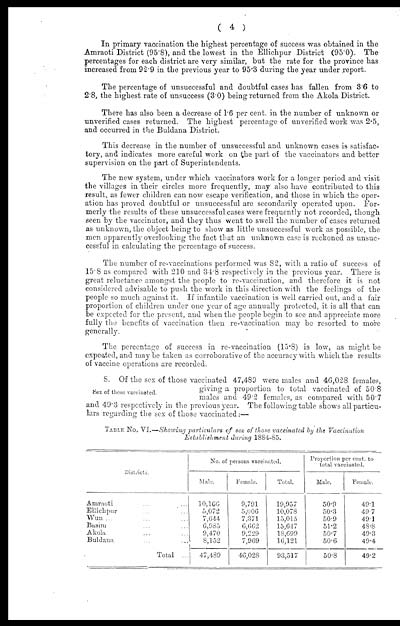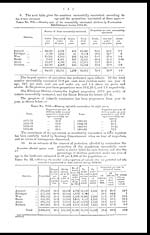Medicine - Vaccination > 1872-1903 - Report on vaccination in the Hyderabad Assigned Districts > Vaccination Hyderabad 1872-1889 > 1884-1885 - Report on vaccination in the Hyderabad Assigned Districts, for the official year 1884-85
(330) Page 4
Download files
Individual page:
Thumbnail gallery: Grid view | List view

( 4 )
In primary vaccination the highest percentage of success was obtained in the
Amraoti District (95.8), and the lowest in the Ellichpur District (95.0). The
percentages for each district are very similar, but the rate for the province has
increased from 92.9 in the previous year to 95.3 during the year under report.
The percentage of unsuccessful and doubtful cases has fallen from 3.6 to
2.8, the highest rate of unsuccess (3.0) being returned from the Akola District.
There has also been a decrease of 1.6 per cent. in the number of unknown or
unverified cases returned. The highest percentage of unverified work was 2.5,
and occurred in the Buldana District.
This decrease in the number of unsuccessful and unknown cases is satisfac-
tory, and indicates more careful work on the part of the vaccinators and better
supervision on the part of Superintendents.
The new system, under which vaccinators work for a longer period and visit
the villages in their circles more frequently, may also have contributed to this
result, as fewer children can now escape verification, and those in which the oper-
ation has proved doubtful or unsuccessful are secondarily operated upon. For-
merly the results of these unsuccessful cases were frequently not recorded, though
seen by the vaccinator, and they thus went to swell the number of cases returned
as unknown, the object being to show as little unsuccessful work as possible, the
men apparently overlooking the fact that an unknown case is reckoned as unsuc-
cessful in calculating the percentage of success.
The number of re-vaccinations performed was 82, with a ratio of success of
15.8 as compared with 210 and 34.8 respectively in the previous year. There is
great reluctance amongst the people to re-vaccination, and therefore it is not
considered advisable to push the work in this direction with the feelings of the
people so much against it. If infantile vaccination is well carried out, and a fair
proportion of children under one year of age annually protected, it is all that can
be expected for the present, and when the people begin to see and appreciate more
fully the benefits of vaccination then re-vaccination may be resorted to more
generally.
The percentage of success in re-vaccination (15.8) is low, as might be
expected, and may be taken as corroborative of the accuracy with which the results
of vaccine operations are recorded.
Sex of those vaccinated.
8. Of the sex of those vaccinated 47,489 were males and 46,028 females,
giving a proportion to total vaccinated of 50.8
males and 49.2 females, as compared with 50.7
and 49.3 respectively in the previous year. The following table shows all particu-
lars regarding the sex of those vaccinated:—
TABLE No, VI.—Showing particulars of sex of those vaccinated by the Vaccination
Establishment during 1884-85.
|
Districts. |
No. of persons vaccinated. |
Proportion per cent. to |
|||
|
Male. |
Female. |
Total. |
Male. |
Female. |
|
|
Amraoti ... ... |
10,166 |
9,791 |
19,957 |
50.9 |
49.1 |
|
Ellichpur ... ... |
5,072 |
5,006 |
10,078 |
50.3 |
49.7 |
|
Wun ... ... |
7,644 |
7,371 |
15,015 |
50.9 |
49.1 |
|
Basim ... ... |
6,985 |
6,662 |
15,647 |
51.2 |
48.8 |
|
Akola ... ... |
9,470 |
9,229 |
18,699 |
50.7 |
49.3 |
|
Buldana ... ... |
8,152 |
7,969 |
16,121 |
50.6 |
49.4 |
|
Total ... |
47,489 |
46,028 |
93,517 |
50.8 |
49.2 |
Set display mode to: Large image | Zoom image | Transcription
Images and transcriptions on this page, including medium image downloads, may be used under the Creative Commons Attribution 4.0 International Licence unless otherwise stated. ![]()
| Permanent URL | https://digital.nls.uk/91172435 |
|---|
| Attribution and copyright: |
|
|---|




